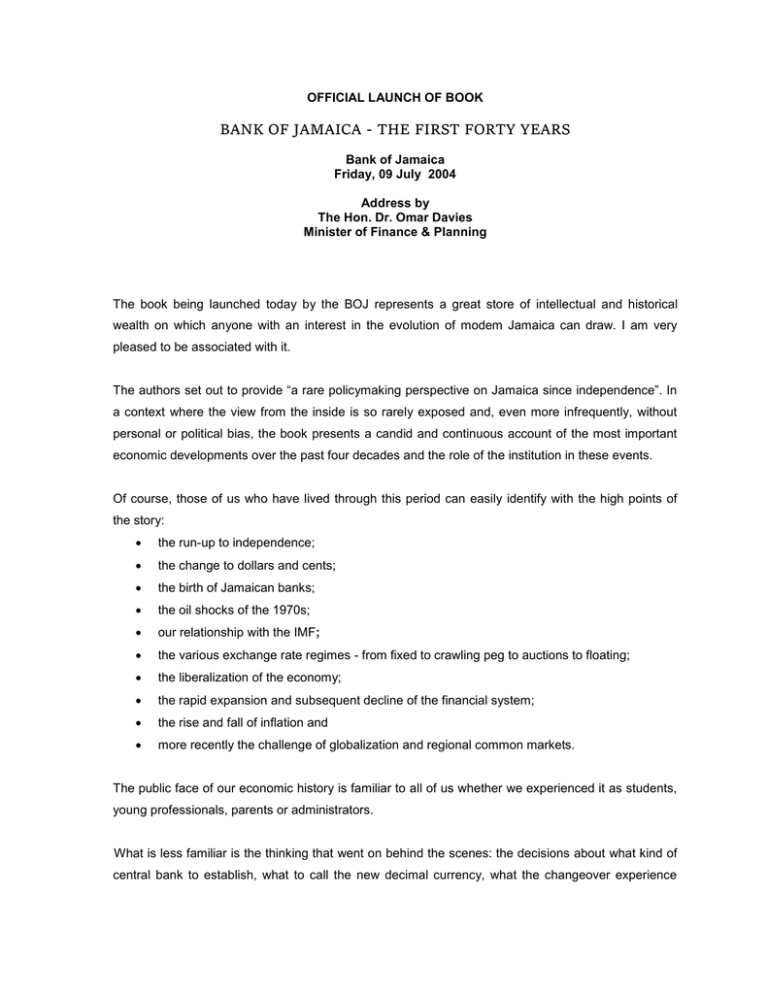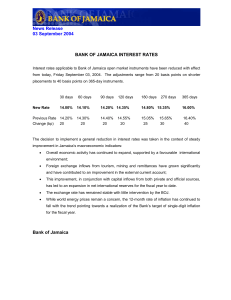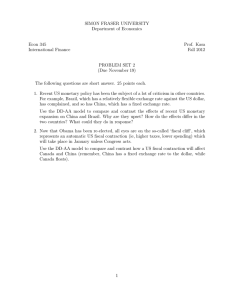BANK OF JAMAICA - THE FIRST FORTY YEARS
advertisement

OFFICIAL LAUNCH OF BOOK BANK OF JAMAICA - THE FIRST FORTY YEARS Bank of Jamaica Friday, 09 July 2004 Address by The Hon. Dr. Omar Davies Minister of Finance & Planning The book being launched today by the BOJ represents a great store of intellectual and historical wealth on which anyone with an interest in the evolution of modem Jamaica can draw. I am very pleased to be associated with it. The authors set out to provide “a rare policymaking perspective on Jamaica since independence”. In a context where the view from the inside is so rarely exposed and, even more infrequently, without personal or political bias, the book presents a candid and continuous account of the most important economic developments over the past four decades and the role of the institution in these events. Of course, those of us who have lived through this period can easily identify with the high points of the story: the run-up to independence; the change to dollars and cents; the birth of Jamaican banks; the oil shocks of the 1970s; our relationship with the IMF; the various exchange rate regimes - from fixed to crawling peg to auctions to floating; the liberalization of the economy; the rapid expansion and subsequent decline of the financial system; the rise and fall of inflation and more recently the challenge of globalization and regional common markets. The public face of our economic history is familiar to all of us whether we experienced it as students, young professionals, parents or administrators. What is less familiar is the thinking that went on behind the scenes: the decisions about what kind of central bank to establish, what to call the new decimal currency, what the changeover experience was like, the factors that led to a change in the exchange rate regime, how the internal arrangements for conducting monetary policy have changed, and so on. From this perspective, there is no other source (nor can there be) that can provide authoritative answers to these questions. There are perhaps three areas of the book that are particularly eye-opening ... 1. The discussion of our various exchange rate arrangements 2. The evolution and increasing sophistication of monetary policy 3. The Bank’s view of itself and its future Behind the policy decisions and operations of the Bank have been a set of dedicated persons. Many of you here, I understand, have served the Bank for more than 20 years and more than a few of you worked at the original headquarters before this building was handed over in 1975. I am pleased that while the focus of the book is on the way monetary and financial policies influenced our economic history, a healthy treatment is given to recounting the development of the Bank as an organization and recognition showed to the lasting contribution made by those who served. In assessing the contribution of the Bank of Jamaica to economic management, one should also to indicate the extent to which the issues of greatest relative importance have changed over time. Hence, for example prior to the liberalization of the foreign exchange system, there was a huge department established simply to collect and allocate foreign exchange. Certainly over the last few years, a critical element of the Bank’s contribution has been its role in the overall macro economic programme within which all aspects of public sector operations fall. Hence, whilst for the clients of the Bank, their major concern about the institution’s operations would logically be in terms of that which impacts on them most, for those of us involved in managing the economy as a whole, the BOJ’s role is even greater. Within that context there are clear linkages between GDP growth, the inflation level, foreign exchange market stability, the fiscal balance and the primary surplus. That introduction provides me with a perfect segue into a brief discussion of certain major macroeconomic indicators, Of particular interest is the fiscal balance. You will no doubt recall that following the attainment of the target for fiscal year 03/04, the government’s target for 04/05 was to reduce the deficit to between 3-4% of GDP and to eliminate the deficit in 05/06. Those are ambitious targets and meeting that for the last fiscal year did much to increase confidence, both domestic and external, in the economy. I have just received the preliminary out-turn figures for fiscal Q1 - that is, April to June. They indicate that in terms of revenue for the period we are ahead of budget by 3.8%. In terms of expenditure, we are 2.8% below the budgeted target. This translates in a deficit which is $3.1 billion below what had been projected. To complement this fiscal performance, the news is that STATIN’s official data for the January-March quarter is that GDP growth was 2.5%. However, the economy continues to grow. As regards our two most important foreign exchange earnings areas - bauxite alumina and tourism - the results for the first six (6) months of the calendar year place us significantly about last year, which itself was a record year. In tourism, preliminary visitor arrival figures for 15 December to 07 July put us at 9.0% above the level for the corresponding period last year. For bauxite/alumina, for January to June, alumina production is up 7.8% and total bauxite production up 5.16% above the 2003 period. The data from STATIN for the January to March period, combined with the positive fiscal results for 2004/05, as well as the performances in tourism and bauxite/alumina, provide the objective basis for the increased level of business confidence reported on recently. These developments have not come about by chance. They represent the results of a well thoughtout macro economic programme, involving several public sector institutions, but with the Central Bank playing a critical role, only with regard to its main areas of responsibility but more generally, in fostering overall stability. At this point, I would like to make a few remarks about the present and future areas of emphasis of the Bank. At present, the twin points of focus are monetary stability and the integrity of the financial system. The rationale for these areas of focus should be straightforward. However, as I have pointed out before the areas of emphasis of must change over time. The public debate of the institution’s role has touched, inter alia, on the exchange system, the most appropriate regulatory framework, the optimal balance in conducting monetary policy, as well as e most current issue - the establishment of a Monetary Policy Committee. In terms of prioritizing those issues, there are two (2) critical variables at work. The first is what I call the “optics” and the second would be substantive changes. Both are important and insofar as the Monetary Policy Committee is concerned, whilst due regard is to be given to issues of confidentiality, to the extent that the existence of such a Committee provides the public with a greater comfort level in how monetary policy decision-making is executed, then a worthwhile purpose would indeed be served. What is of importance is that we never get to the point of seeing solutions as a binary operation either one is totally wrong or the solution to all problems lies in adopting a specific model. We need to have the self-confidence to build our own solutions, obviously taking into consideration experiences elsewhere, but no less important, our own experiences, including the most efficient use of the resources which we have available. Putting all the above together, I have no doubt that over the next several years there will be changes to the major areas of focus of the Central Bank, as well as its interface the public. Such changes are inevitable. What is important is that we have enough self-confidence in the competence and ability of our own professionals that we can design solutions to the problems which face us in this ever changing world. CONCLUSION If there is one overriding lesson to de drawn from the book, it is that a well-organized, properly run central bank can make a vast difference to the quality of people’s lives. Its actions impinge on every aspect the society and economy. I commend the “First 40 Years” to your reading and reflection and heartiest congratulations to the Bank on its publication.







